| Solar eclipse of February 4, 1943 | |
|---|---|
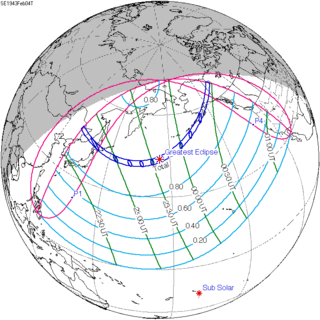 Map Map | |
| Type of eclipse | |
| Nature | Total |
| Gamma | 0.8734 |
| Magnitude | 1.0331 |
| Maximum eclipse | |
| Duration | 159 s (2 min 39 s) |
| Coordinates | 43°36′N 175°06′E / 43.6°N 175.1°E / 43.6; 175.1 |
| Max. width of band | 229 km (142 mi) |
| Times (UTC) | |
| Greatest eclipse | 23:38:10 |
| References | |
| Saros | 120 (57 of 71) |
| Catalog # (SE5000) | 9382 |
A total solar eclipse occurred at the Moon's descending node of orbit between Thursday, February 4 and Friday, February 5, 1943, with a magnitude of 1.0331. A solar eclipse occurs when the Moon passes between Earth and the Sun, thereby totally or partly obscuring the image of the Sun for a viewer on Earth. A total solar eclipse occurs when the Moon's apparent diameter is larger than the Sun's, blocking all direct sunlight, turning day into darkness. Totality occurs in a narrow path across Earth's surface, with the partial solar eclipse visible over a surrounding region thousands of kilometres wide. Occurring about 22 hours after perigee (on February 4, 1943, at 1:30 UTC), the Moon's apparent diameter was larger.
It began on the morning on February 5 (Friday) over northeastern China (then occupied by Manchukuo), Primorsky Krai in the Soviet Union (now Russia), Hokkaido and southern Kunashir Island in Japan (Kunashir now belonging to Russia) and ended at sunset on February 4 (Thursday) over Alaska and Yukon in Canada. A partial eclipse was visible for parts of East Asia, Hawaii, and western North America.
Observations
In China, the eclipse occurred on February 5, the exact date of the Lunar New Year. However it was during the Second Sino-Japanese War and all the areas within the path of totality which is now in China were then under the control of Manchukuo, a Japanese puppet state. Chinese scientists did not make any observation for scientific purposes. A short report with the title "Tokyo total solar eclipse" was published in Kuomintang's official newspaper Central Daily News. Actually, Tokyo was out of the path of totality and only a partial eclipse was visible.
The Japanese headquarters of the International Latitude Observatory, the predecessor of the Mizusawa VLBI Observatory [ja] of the National Astronomical Observatory of Japan in Mizusawa, Iwate (now part of the city of Ōshū) sent an observation team to Kushiro, Hokkaido. Seiichi Oikawa, a member of the team, took photos of the total eclipse. In Kushiro the weather conditions were good and the solar eclipse began at 6:46 am, 11 minutes after sunrise. About 1 hour and 5 minutes later, the sun was completely covered by the moon and the totality phase was seen for less than 2 minutes.
In the Territory of Alaska (now the state of Alaska), a total eclipse was visible from cities including Seward, Valdez and Kodiac. Alaska's largest city, Anchorage was located near the northern edge of the path of totality. A total eclipse was visible in the southeastern part of the city. The University of Alaska held a conference on February 4, the exact day of the eclipse, to explain in-depth information on the eclipse.
Eclipse details
Shown below are two tables displaying details about this particular solar eclipse. The first table outlines times at which the moon's penumbra or umbra attains the specific parameter, and the second table describes various other parameters pertaining to this eclipse.
| Event | Time (UTC) |
|---|---|
| First Penumbral External Contact | 1943 February 04 at 21:26:44.5 UTC |
| First Umbral External Contact | 1943 February 04 at 22:46:38.7 UTC |
| First Central Line | 1943 February 04 at 22:48:02.2 UTC |
| First Umbral Internal Contact | 1943 February 04 at 22:49:27.4 UTC |
| Ecliptic Conjunction | 1943 February 04 at 23:29:20.2 UTC |
| Greatest Duration | 1943 February 04 at 23:37:07.6 UTC |
| Greatest Eclipse | 1943 February 04 at 23:38:10.3 UTC |
| Equatorial Conjunction | 1943 February 04 at 23:56:42.1 UTC |
| Last Umbral Internal Contact | 1943 February 05 at 00:26:41.1 UTC |
| Last Central Line | 1943 February 05 at 00:28:05.3 UTC |
| Last Umbral External Contact | 1943 February 05 at 00:29:27.7 UTC |
| Last Penumbral External Contact | 1943 February 05 at 01:49:29.8 UTC |
| Parameter | Value |
|---|---|
| Eclipse Magnitude | 1.03313 |
| Eclipse Obscuration | 1.06736 |
| Gamma | 0.87335 |
| Sun Right Ascension | 21h11m02.0s |
| Sun Declination | -16°15'11.5" |
| Sun Semi-Diameter | 16'13.3" |
| Sun Equatorial Horizontal Parallax | 08.9" |
| Moon Right Ascension | 21h10m17.8s |
| Moon Declination | -15°23'06.3" |
| Moon Semi-Diameter | 16'37.6" |
| Moon Equatorial Horizontal Parallax | 1°01'01.1" |
| ΔT | 25.7 s |
Eclipse season
See also: Eclipse cycleThis eclipse is part of an eclipse season, a period, roughly every six months, when eclipses occur. Only two (or occasionally three) eclipse seasons occur each year, and each season lasts about 35 days and repeats just short of six months (173 days) later; thus two full eclipse seasons always occur each year. Either two or three eclipses happen each eclipse season. In the sequence below, each eclipse is separated by a fortnight.
| February 4 Descending node (new moon) |
February 20 Ascending node (full moon) |
|---|---|
 |

|
| Total solar eclipse Solar Saros 120 |
Partial lunar eclipse Lunar Saros 132 |
Related eclipses
Eclipses in 1943
- A total solar eclipse on February 4.
- A partial lunar eclipse on February 20.
- An annular solar eclipse on August 1.
- A partial lunar eclipse on August 15.
Metonic
- Preceded by: Solar eclipse of April 19, 1939
- Followed by: Solar eclipse of November 23, 1946
Tzolkinex
- Preceded by: Solar eclipse of December 25, 1935
- Followed by: Solar eclipse of March 18, 1950
Half-Saros
- Preceded by: Lunar eclipse of January 30, 1934
- Followed by: Lunar eclipse of February 11, 1952
Tritos
- Preceded by: Solar eclipse of March 7, 1932
- Followed by: Solar eclipse of January 5, 1954
Solar Saros 120
- Preceded by: Solar eclipse of January 24, 1925
- Followed by: Solar eclipse of February 15, 1961
Inex
- Preceded by: Solar eclipse of February 25, 1914
- Followed by: Solar eclipse of January 16, 1972
Triad
- Preceded by: Solar eclipse of April 5, 1856
- Followed by: Solar eclipse of December 5, 2029
Solar eclipses of 1942–1946
This eclipse is a member of a semester series. An eclipse in a semester series of solar eclipses repeats approximately every 177 days and 4 hours (a semester) at alternating nodes of the Moon's orbit.
The partial solar eclipses on March 16, 1942 and September 10, 1942 occur in the previous lunar year eclipse set, and the partial solar eclipses on May 30, 1946 and November 23, 1946 occur in the next lunar year eclipse set.
| Solar eclipse series sets from 1942 to 1946 | ||||||
|---|---|---|---|---|---|---|
| Ascending node | Descending node | |||||
| Saros | Map | Gamma | Saros | Map | Gamma | |
| 115 | August 12, 1942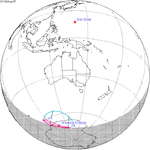 Partial |
−1.5244 | 120 | February 4, 1943 Total |
0.8734 | |
| 125 | August 1, 1943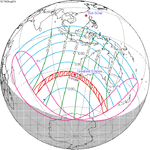 Annular |
−0.8041 | 130 | January 25, 1944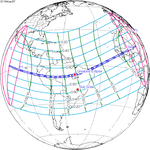 Total |
0.2025 | |
| 135 | July 20, 1944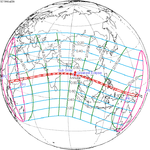 Annular |
−0.0314 | 140 | January 14, 1945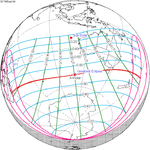 Annular |
−0.4937 | |
| 145 | July 9, 1945 Total |
0.7356 | 150 | January 3, 1946 Partial |
−1.2392 | |
| 155 | June 29, 1946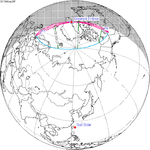 Partial |
1.4361 | ||||
Saros 120
This eclipse is a part of Saros series 120, repeating every 18 years, 11 days, and containing 71 events. The series started with a partial solar eclipse on May 27, 933 AD. It contains annular eclipses from August 11, 1059 through April 26, 1492; hybrid eclipses from May 8, 1510 through June 8, 1564; and total eclipses from June 20, 1582 through March 30, 2033. The series ends at member 71 as a partial eclipse on July 7, 2195. Its eclipses are tabulated in three columns; every third eclipse in the same column is one exeligmos apart, so they all cast shadows over approximately the same parts of the Earth.
The longest duration of annularity was produced by member 11 at 6 minutes, 24 seconds on September 11, 1113, and the longest duration of totality was produced by member 60 at 2 minutes, 50 seconds on March 9, 1997. All eclipses in this series occur at the Moon’s descending node of orbit.
| Series members 50–71 occur between 1801 and 2195: | ||
|---|---|---|
| 50 | 51 | 52 |
 November 19, 1816 |
 November 30, 1834 |
 December 11, 1852 |
| 53 | 54 | 55 |
 December 22, 1870 |
 January 1, 1889 |
 January 14, 1907 |
| 56 | 57 | 58 |
 January 24, 1925 |
 February 4, 1943 |
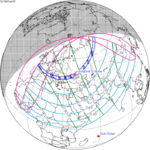 February 15, 1961 |
| 59 | 60 | 61 |
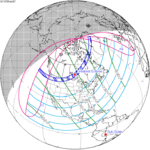 February 26, 1979 |
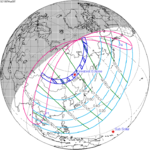 March 9, 1997 |
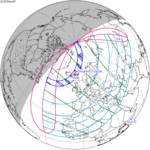 March 20, 2015 |
| 62 | 63 | 64 |
 March 30, 2033 |
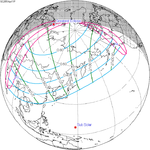 April 11, 2051 |
 April 21, 2069 |
| 65 | 66 | 67 |
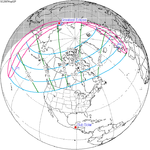 May 2, 2087 |
 May 14, 2105 |
 May 25, 2123 |
| 68 | 69 | 70 |
 June 4, 2141 |
 June 16, 2159 |
 June 26, 2177 |
| 71 | ||
 July 7, 2195 | ||
Metonic series
The metonic series repeats eclipses every 19 years (6939.69 days), lasting about 5 cycles. Eclipses occur in nearly the same calendar date. In addition, the octon subseries repeats 1/5 of that or every 3.8 years (1387.94 days). All eclipses in this table occur at the Moon's descending node.
| 22 eclipse events between September 12, 1931 and July 1, 2011 | ||||
|---|---|---|---|---|
| September 11–12 | June 30–July 1 | April 17–19 | February 4–5 | November 22–23 |
| 114 | 116 | 118 | 120 | 122 |
 September 12, 1931 |
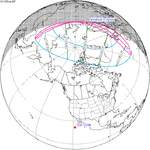 June 30, 1935 |
 April 19, 1939 |
 February 4, 1943 |
 November 23, 1946 |
| 124 | 126 | 128 | 130 | 132 |
 September 12, 1950 |
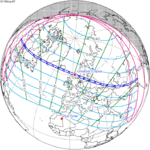 June 30, 1954 |
 April 19, 1958 |
 February 5, 1962 |
 November 23, 1965 |
| 134 | 136 | 138 | 140 | 142 |
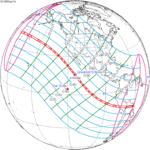 September 11, 1969 |
 June 30, 1973 |
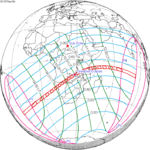 April 18, 1977 |
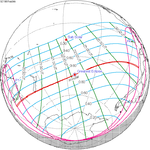 February 4, 1981 |
 November 22, 1984 |
| 144 | 146 | 148 | 150 | 152 |
 September 11, 1988 |
 June 30, 1992 |
 April 17, 1996 |
 February 5, 2000 |
 November 23, 2003 |
| 154 | 156 | |||
 September 11, 2007 |
 July 1, 2011 | |||
Tritos series
This eclipse is a part of a tritos cycle, repeating at alternating nodes every 135 synodic months (≈ 3986.63 days, or 11 years minus 1 month). Their appearance and longitude are irregular due to a lack of synchronization with the anomalistic month (period of perigee), but groupings of 3 tritos cycles (≈ 33 years minus 3 months) come close (≈ 434.044 anomalistic months), so eclipses are similar in these groupings.
| Series members between 1801 and 2200 | ||||
|---|---|---|---|---|
 March 14, 1801 (Saros 107) |
 February 12, 1812 (Saros 108) |
 January 12, 1823 (Saros 109) |
 November 10, 1844 (Saros 111) | |
 August 9, 1877 (Saros 114) |
 July 9, 1888 (Saros 115) |
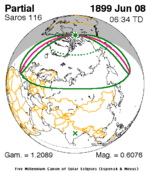 June 8, 1899 (Saros 116) | ||
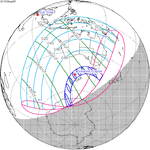 May 9, 1910 (Saros 117) |
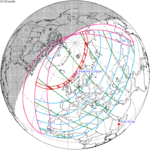 April 8, 1921 (Saros 118) |
 March 7, 1932 (Saros 119) |
 February 4, 1943 (Saros 120) |
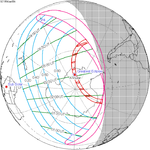 January 5, 1954 (Saros 121) |
 December 4, 1964 (Saros 122) |
 November 3, 1975 (Saros 123) |
 October 3, 1986 (Saros 124) |
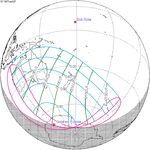 September 2, 1997 (Saros 125) |
 August 1, 2008 (Saros 126) |
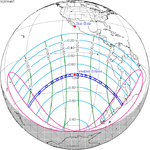 July 2, 2019 (Saros 127) |
 June 1, 2030 (Saros 128) |
 April 30, 2041 (Saros 129) |
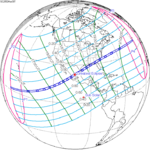 March 30, 2052 (Saros 130) |
 February 28, 2063 (Saros 131) |
 January 27, 2074 (Saros 132) |
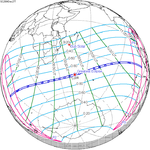 December 27, 2084 (Saros 133) |
 November 27, 2095 (Saros 134) |
 October 26, 2106 (Saros 135) |
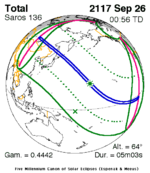 September 26, 2117 (Saros 136) |
 August 25, 2128 (Saros 137) |
 July 25, 2139 (Saros 138) |
 June 25, 2150 (Saros 139) |
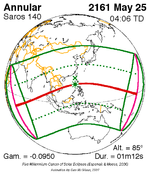 May 25, 2161 (Saros 140) |
 April 23, 2172 (Saros 141) |
 March 23, 2183 (Saros 142) |
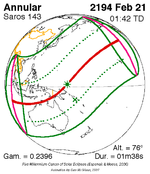 February 21, 2194 (Saros 143) | |||
Inex series
This eclipse is a part of the long period inex cycle, repeating at alternating nodes, every 358 synodic months (≈ 10,571.95 days, or 29 years minus 20 days). Their appearance and longitude are irregular due to a lack of synchronization with the anomalistic month (period of perigee). However, groupings of 3 inex cycles (≈ 87 years minus 2 months) comes close (≈ 1,151.02 anomalistic months), so eclipses are similar in these groupings.
| Series members between 1801 and 2200 | ||
|---|---|---|
 April 26, 1827 (Saros 116) |
 April 5, 1856 (Saros 117) |
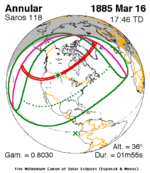 March 16, 1885 (Saros 118) |
 February 25, 1914 (Saros 119) |
 February 4, 1943 (Saros 120) |
 January 16, 1972 (Saros 121) |
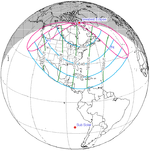 December 25, 2000 (Saros 122) |
 December 5, 2029 (Saros 123) |
 November 16, 2058 (Saros 124) |
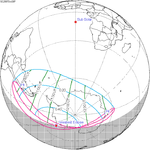 October 26, 2087 (Saros 125) |
 October 6, 2116 (Saros 126) |
 September 16, 2145 (Saros 127) |
 August 27, 2174 (Saros 128) |
||
Notes
- "February 4–5, 1943 Total Solar Eclipse". timeanddate. Retrieved 4 August 2024.
- "Moon Distances for London, United Kingdom, England". timeanddate. Retrieved 4 August 2024.
- "《新闻调查》 19970314 寻踪日全食" (in Chinese). China Central Television. 14 March 1997. Archived from the original on 10 July 2015.
- "日本公开1943年拍摄的日全食照片" (in Chinese). Archived from the original on 2020-05-01.
- "北海道の広い範囲で皆既日食" (in Japanese). Retrieved 21 August 2019.
- The University of Alaska (1 March 1943). "Farthest-North Collegian" (pdf). Farthest-North Collegian.
- "Total Solar Eclipse of 1943 Feb 04". EclipseWise.com. Retrieved 4 August 2024.
- van Gent, R.H. "Solar- and Lunar-Eclipse Predictions from Antiquity to the Present". A Catalogue of Eclipse Cycles. Utrecht University. Retrieved 6 October 2018.
- "NASA - Catalog of Solar Eclipses of Saros 120". eclipse.gsfc.nasa.gov.
References
- Earth visibility chart and eclipse statistics Eclipse Predictions by Fred Espenak, NASA/GSFC


